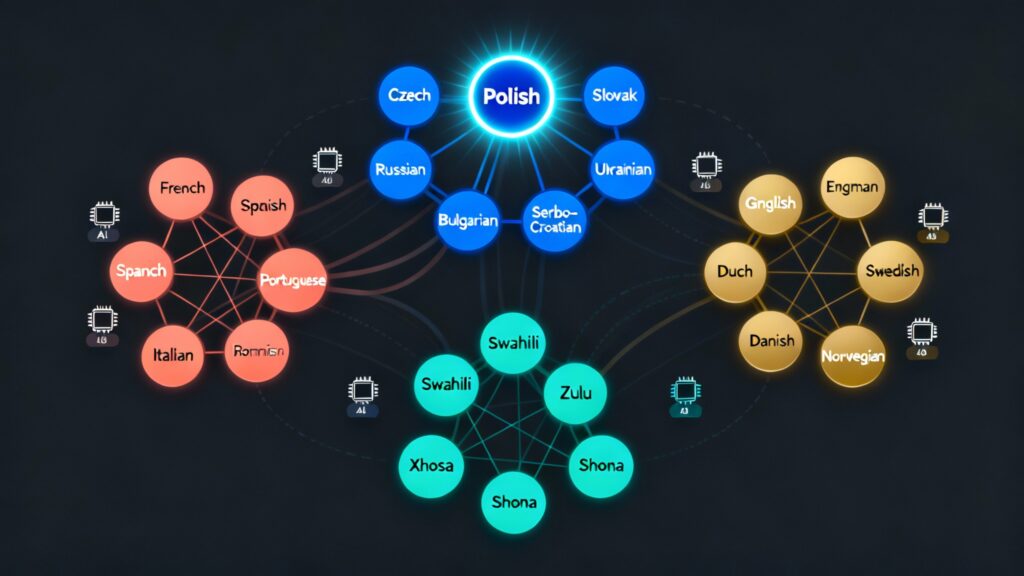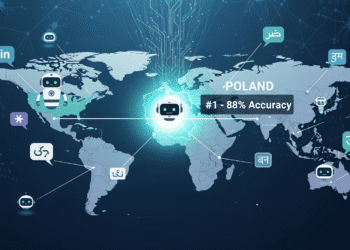Groundbreaking study reveals surprising results that challenge assumptions about artificial intelligence and language processing

The Unexpected Champion
Here’s something that’ll make you do a double-take. Polish—yes, the language often cited as one of the toughest for humans to learn has emerged as the most effective language for communicating with artificial intelligence. English? It didn’t even crack the top five.
A collaborative study conducted by researchers from the University of Maryland, the University of Massachusetts Amherst, and Microsoft has turned conventional wisdom on its head. Out of 26 languages tested, Polish achieved an impressive 88% accuracy rate when prompting AI models to complete complex tasks. English limped in at sixth place with just 83.9% accuracy.
“Our experiment yielded some surprising and unintuitive findings,” the researchers wrote in their report. They weren’t kidding.
How the Research Unfolded
The research team put six major large language models (LLMs) through their paces. These included systems from OpenAI, Google Gemini, Qwen, Llama, and DeepSeek. LLMs are the AI programs that power chatbots like ChatGPT and other conversational AI tools we’ve all been experimenting with lately.
The methodology was straightforward but comprehensive. Researchers fed identical inputs to these AI systems in 26 different languages. Then they measured how accurately each model responded. The tasks varied in complexity, with the most challenging ones involving processing massive amounts of text up to 128,000 tokens, which is roughly equivalent to a short novel.
What they discovered defied expectations. Polish consistently outperformed every other language tested, including the two languages that dominate AI training data: English and Chinese.
The Top Ten Performers
The results paint an interesting picture of linguistic effectiveness in the AI realm. Here’s how the top ten languages stacked up:
Polish led the pack at 88%, followed closely by French at 87%. Italian claimed third place with 86%, while Spanish secured fourth with 85%. Russian rounded out the top five at 84%.
English, despite being the lingua franca of technology and the internet, managed only sixth place at 83.9%. Ukrainian came in seventh at 83.5%, with Portuguese at 82%, German at 81%, and Dutch closing out the top ten at 80%.
Why This Matters
The implications of this research extend far beyond academic curiosity. As AI becomes increasingly integrated into our daily lives from customer service chatbots to virtual assistants—understanding which languages work best could reshape how we interact with these systems.
The Polish Patent Office couldn’t contain its excitement. In a Facebook post, they noted: “As the analysis shows, it is the most precise in terms of giving commands to artificial intelligence. Until now, Polish was widely regarded as one of the most difficult languages to learn. As it turns out, humans have trouble with it, but not AI.”
There’s a delicious irony here. The very complexity that makes Polish challenging for human learners might be what makes it so effective for AI communication.
The Chinese Puzzle
Perhaps even more surprising than Polish’s success was Chinese’s failure. Chinese ranked fourth from the bottom out of all 26 languages tested, achieving only 62.1% accuracy. This is particularly puzzling because Chinese, like English, dominates the datasets used to train these AI models.
“English and Chinese dominate the pretraining data…and so we might expect them to be the top-performing languages,” the researchers explained. “However, at context lengths of 64K and 128K, we unexpectedly observe that Polish is the top performer.”
This finding challenges a fundamental assumption in AI development. More training data doesn’t automatically translate to better performance.
Language Families and Performance Patterns

The study revealed clear patterns when languages were grouped by family. Slavic languages—including Polish and Russian performed exceptionally well. Romance languages like French, Italian, and Spanish also showed strong results. Germanic languages, including English and German, held their own but didn’t dominate.
On the flip side, Bantu languages struggled significantly. Swahili and Sethoto ranked near the bottom, despite Bantu languages collectively having over 350 million speakers worldwide. This disparity raises important questions about representation and equity in AI development.
The Script Factor
One key factor influencing performance appears to be the writing system itself. Languages using Latin or Cyrillic scripts consistently outperformed those using other writing systems. This suggests that the visual representation of language not just its structure or vocabulary plays a crucial role in how AI processes information.
The researchers also pointed to the concept of “high resource” versus “low resource” languages. High resource languages have abundant data available for training AI systems. Low resource languages have less. Interestingly, Polish’s strong performance came despite having significantly less training data available than English or Chinese.
Poland’s AI Ambitions
Poland hasn’t been sitting idle while researchers study these phenomena. Earlier this year, the Polish government launched PLLuM the Polish Large Language Model. This freely available AI tool aims to support artificial intelligence development specifically for Polish language applications.
The project has practical goals beyond national pride. PLLuM is designed to improve public services throughout Poland. In August, the city of Częstochowa became the first municipality to implement PLLuM for government operations. City officials now use it to draft official correspondence faster, analyze citizen inquiries, and summarize lengthy documents.
This real-world application demonstrates how language-specific AI models can enhance efficiency in government services. It’s not just about bragging rights it’s about making bureaucracy work better for citizens.
What Makes Polish Special?
So what gives Polish its edge? Linguists and AI researchers are still unpacking this question, but several theories have emerged.
Polish is a highly inflected language. Words change form based on their grammatical function in a sentence. This complexity might actually help AI systems by providing more contextual clues within the language structure itself. Where English relies heavily on word order, Polish embeds grammatical information directly into words.
The language also features a rich system of consonant clusters and phonetic distinctions that might translate into more precise digital encoding. When AI processes Polish text, it may be working with a more information-dense linguistic structure.
The Broader Implications
This research has significant implications for global AI development. Tech companies have largely focused on optimizing AI for English, assuming it would provide the best results. This study suggests that assumption needs serious reconsideration.
For businesses operating internationally, these findings could influence which languages they prioritize for AI-powered customer service. For developers creating AI applications, it might mean rethinking which languages to use for training and testing.
The research also highlights potential biases in current AI systems. If certain language families consistently underperform, it could mean that speakers of those languages receive inferior AI services. That’s not just a technical problem it’s an equity issue.
Challenges and Questions
The study raises as many questions as it answers. Why do some languages work better than others? Is it purely structural, or do cultural factors embedded in language use play a role? Can AI systems be optimized to work equally well across all languages?
There’s also the question of practical application. Should people start prompting AI in Polish even if it’s not their native language? That seems impractical for most users. More likely, these findings will inform how AI developers train and optimize their models.
The Future of Multilingual AI
As AI continues to evolve, understanding these linguistic nuances becomes increasingly important. The goal isn’t to make everyone use Polish to talk to their AI assistants. Rather, it’s to understand what makes certain languages more effective so that AI can be improved across all languages.
Researchers are already calling for more comprehensive studies. Testing additional languages, exploring different types of AI tasks, and investigating the underlying mechanisms that make some languages more effective could all yield valuable insights.
Poland’s Growing Tech Presence
This research arrives as Poland strengthens its position in the European tech landscape. The country has been investing heavily in digital infrastructure and AI development. The PLLuM project represents just one facet of a broader national strategy to become a leader in artificial intelligence.
Polish universities are expanding their AI research programs. Tech startups in Warsaw, Kraków, and other cities are attracting international investment. The discovery that Polish works exceptionally well with AI could accelerate these trends, attracting more AI-focused companies and researchers to the country.
What This Means for Users
For the average person using AI tools, these findings might not change much immediately. ChatGPT and similar services will continue working in whatever language you prefer. But behind the scenes, this research could drive improvements in how AI handles multiple languages.
Developers might start using Polish as a benchmark for testing AI performance. They might study Polish’s linguistic features to improve AI’s handling of other languages. Over time, this could lead to better AI experiences for everyone, regardless of which language they speak.
The Road Ahead
The researchers behind this study acknowledge that their work is just the beginning. They’ve opened a door to understanding how language structure affects AI performance, but there’s much more to explore.
Future research will likely investigate why Polish performs so well. Scientists will dig deeper into the linguistic features that give it an advantage. They’ll test more languages, especially those underrepresented in current AI training data. And they’ll work on developing AI systems that perform equally well across all languages.
A Wake-Up Call for AI Development

Perhaps the most important takeaway from this research is that assumptions in AI development need constant challenging. The tech industry assumed English would be optimal for AI. That assumption was wrong.
This discovery should prompt developers to question other assumptions. What else might we be getting wrong about how AI processes information? What other languages or linguistic features might offer unexpected advantages?
The Polish language’s surprising success with AI reminds us that technology development isn’t just about coding and computing power. Language, culture, and human communication patterns all play crucial roles in how effectively we can interact with artificial intelligence.
As we move forward into an increasingly AI-integrated world, understanding these nuances will only become more important. The Polish language has given us an unexpected lesson: sometimes the most complex paths lead to the clearest communication.









